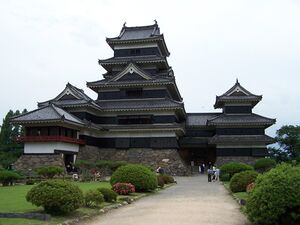Matsumoto castle
- Japanese:松本城(Matsumoto-jou)
- Type:Flatland
- Founder:Ishikawa Kazumasa, Ishikawa Yasunaga
- Year:1597
Matsumoto castle was originally known as Fukashi castle and is located in Matsumoto City in modern day Nagano Prefecture (in a section belonging to the former province of Shinano). This area by the Japan Alps was controlled by the Ogasawara family from the thirteenth through the sixteenth centuries until 1550 when they were conquered by Takeda Shingen. It remained under the auspices of the Takeda until Shingen’s death, when the Ogasawara again took possession. After the forces of Toyotomi Hideyoshi defeated the Hojo at Odawara castle, the Ogasawara were moved Ito the Kanto. Hideyoshi then gave control of Matsumoto to his vassal Ishikawa Kazumasa. In 1593 a major remodeling was undertaken by Kazumasa of the original castle built in 1504. Although he died later that year, the work was completed by his son Yasunaga in 1597. In the province shuffling engaged in by Tokugawa Ieyasu after the Battle Of Sekigahara, the Ogasawara were given Matsumoto for the third time. It was subsequently passed to the Matsudaira (who undertook additional construction), Hotta, and Mizuno clans. Finally, in 1725, the Toda were ensconced as its rulers and remained so until the Meiji Restoration.
Today, the castle is one of the more outstanding examples of hirajiro to survive. The castle grounds are about 170 meters long and 120 meters wide, and are surrounded by three moats. The Great Tenshu of the castle has six interior and five interior floors, and is connected to the Inui Kotenshu (northeast small tenshu) of four interior and three exterior floors. On the east is the two floored Tatsumi Tsukeyagura (southeast connecting tower), and somewhat further away in line with this is the one story Tsukimi Yagura (moon viewing tower). The Great Tenshu and Inui Kotenshu were built by the Ishikawa, while the other two structures were added by the Matsudaira sometime between 1624-44.
The Great Tenshu is thirty meters high. The Tsukimi Yagura is built in a residential shoin style and has red-lacquered railings on its balcony. These contrast nicely with the striking grey roof, upper white plaster, and lower black wood pattern of each story of the complex. The ishigaki is only seven meters tall and consists of random stone pilings in the ranseki-zumi style. The slope of the ishigaki is also less pronounced than that of other castles built during this time period. The castle was built on marshland which necessitated extensive subterranean pile driving procedures to ensure its stability. While most consider the White Heron Castle at Himeji to be the most beautiful of Japanese castles, the black castle of Matsumoto also has its fair share of adherents.
References
- Kodama Kota & Tsuboi Kiyotari, editors Nihon Joukaku Taikei-20 Volumes Tokyo:Shinjimbutsu oraisha, 1981
- Hinago Motoo Nihon No Bijutsu #54:Shiro Tokyo:Shibundo, 1970
- Schmorleitz, Morton S Castles In Japan Tokyo:Charles E Tuttle Company Inc, 1974
